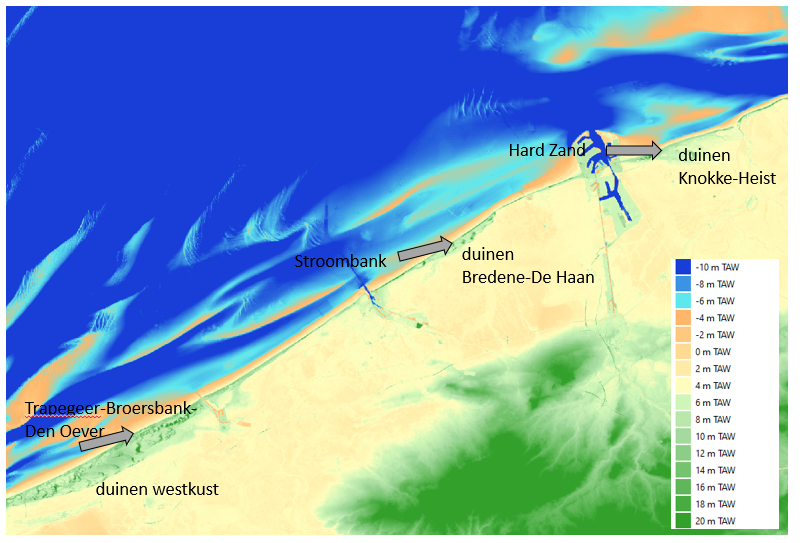T. Verwaest1*, A. Dujardin2, A. Nnafie3, R. Houthuys4, B. Röbke5
1 Flanders Hydraulics; 2 Antea Group Belgium; 3 Utrecht University (IMAU); 4 Geoconsultant; 5 Deltares;
*corresponding author:
Introduction
Within the framework of a new research project called MOZES, in the coming years 2022-2026 the importance of the seabed for sustainable coastal protection of the Belgian coast will be addressed. It is well known that the dunes are the natural sea defences but less known is that these dunes were formed through a process of natural feeding from the channel-bank system of the shoreface-connected sand ridges. Figure 1 shows the locations of three wider dune areas, which seem to coincide with the landward ends of the three shoreface-connected ridges. This suggests that the ridges have provided sand to shape these dunes, a process that took place on centennial time scales. By order of magnitude, this involves about an intensity of 200,000 m3/year over a period of 1000 years. Furthermore, there are zones along the coast with encroaching channels that threaten the stability of beaches. Slowly but steadily, these channels are moving inland and/or deepening. These processes are slow but, in the long term (on decadal time scale), the onshore movement of these channels is expected to lead to an increase of nourishment works to maintain coastal protection at these locations.

Figure 1: shoreface-connected ridges co-occur with wide dune areas at the Belgian coast
Methods
The 2022-2026 MOZES research project combines data-analysis with numerical model development. Older topobathymetric maps are vectorised in order to map the decadal and centennial morphological evolution. The numerical models will address the slow morphodynamics of the shoreface-connected sand ridges and their interaction with the coastline through cross-shore sand transport (either through a natural feeding related to the presence of a coastal bank, or through erosion due to the presence of a coastal channel).
Results
Results achieved in the first year of the MOZES research will be presented in globo in this contribution. More detailed results will be presented in two additional contributions: 1) on data-analysis results (cf. the abstract submitted by Dujardin et al.) and 2) on numerical model development to simulate the morphodynamics on decadal/centennial time scale (cf. the abstract submitted by Nnafie et al.).
References
Dujardin, A.; Houthuys, R.; Nnafie, A.; Röbke, B; van der Werf, J.; de Swart, H.E.; Biernaux, V.; De Maerschalck, B.; Dan, S.; Verwaest, T. (2023). MOZES - Research on the Morphological Interaction between the Sea bottom and the Belgian Coastline: Sub report 1 – Working year 1. FH Reports, 20_079_1. Flanders Hydraulics: Antwerp.
I. Surname1*, F.N. Another-Surname2 , Y. Next-Surname2
1 University Name, Country; 2 Organization Name, Country
* Corresponding author: mail.name@organization.org


